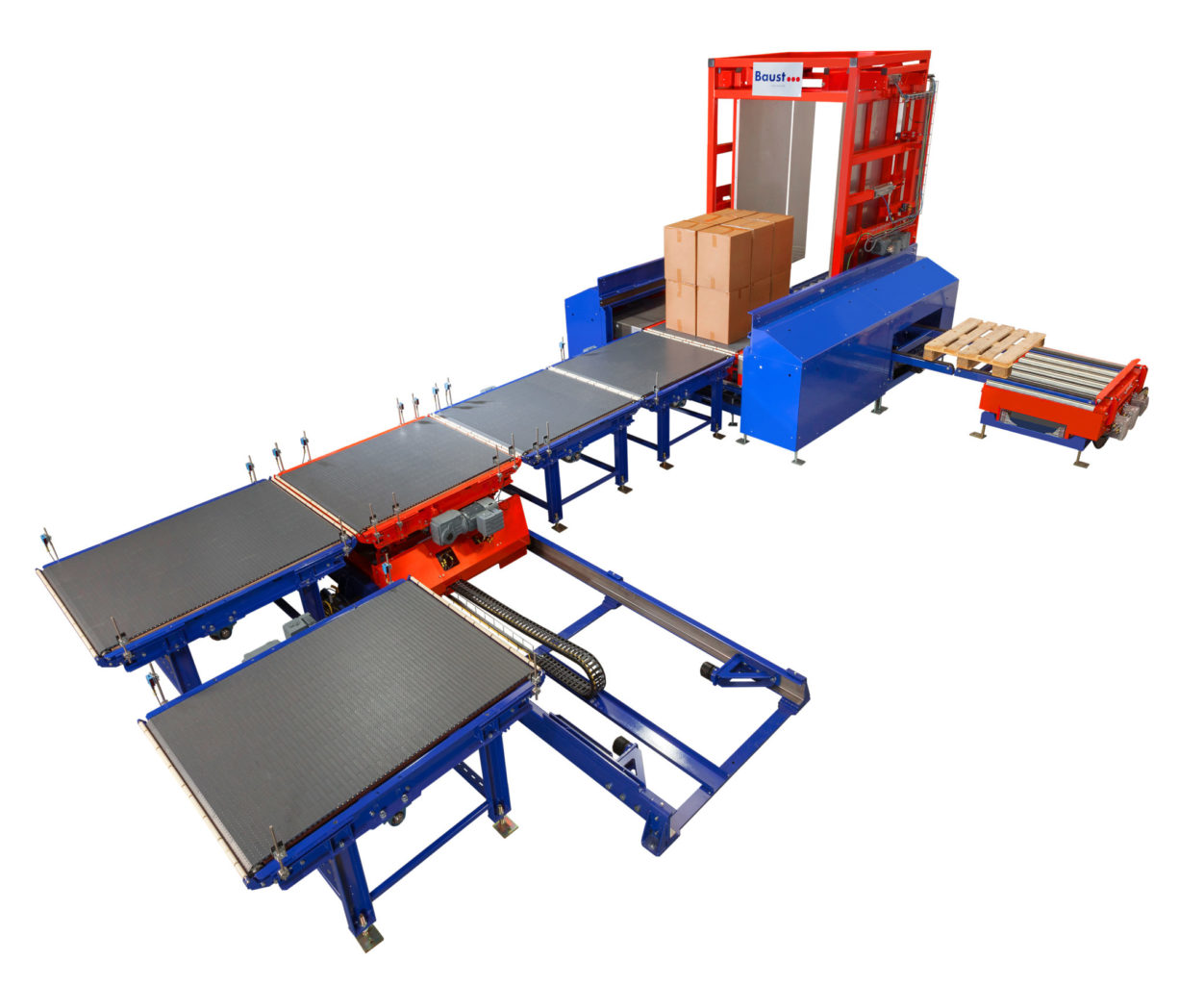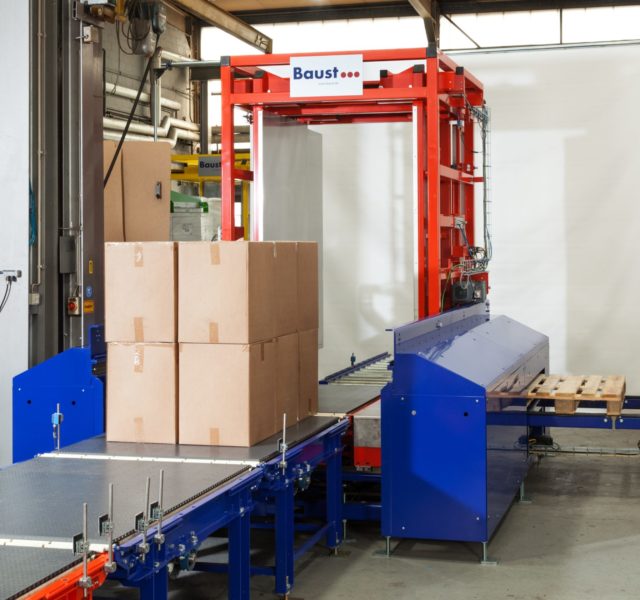Palletizers & palletizing equipment for automatic solutions
High-performance processes with palletizers for effective intralogistics (palletizing)
When loads are to be received, transported or dispatched without pallets in intralogistics, Baust’s high-performance palletizing and systems provide the key technology. Especially in outbound areas for shipping in oversea containers, enormous transport volumes and pallet costs can be saved by excluding pallets. Here, the palletizing systems can push any loads off the pallets much faster, safer and cheaper than manual or robot-assisted unloading. In addition to the pushing method, the clamping or pulling method can be used as an alternative, depending on the pallet and the load. The areas of application of palletizer are oriented towards automated conveyor systems and storage systems with high throughputs in the food, pharmaceutical, logistics, cosmetics and chemical industries.
Your advantages with Baust palletizing systems:
- Palletless export shipping saves transport volume and pallet costs
- No more problems caused by wooden pallets: dirt, control, maintenance, replacement, downtime, malfunctions
- Maximum customization to your requirements with the processes: Pushing, clamping and pulling with palletizing machine
- Use of low-cost, space-saving slipsheets for push-pull forklift attachments instead of pallets
- Up to 5 times faster than other palletizing systems: robot palletizer (robotic palletizing systems), gantry palletizer, layer palletizer
Fully automatic palletizing machines and systems with Baust
Specifications
- performance: 60 – 80 changes/h
- dimensions (L x W x H in mm): 3600x3000x3150
- back & side walls: pneumatically adjustable
- sliding plates: electrically powered
- feeding & discharging: forklift / conveyor systems
- control mode: automatic
- power supply: 4 kVA – 16A 230/400 V R1/2“, 6 bar
- machine weight: approx. 3200 kg
Pallet loading
- total weight up to 1200 kg
- standard pallet (W x L in mm): 800 – 1000 x 1200
- max. height incl. pallet: 2000 mm
- goods: e.g. cartons, drums, boxes, big bags, bags or bottles
- overhang tolerance for each side: 50 mm
Options
- sliding sheets: palletizing on wooden pallet or depalletizing on slip sheet
- slip sheet dispenser & collector (insert link)
- stainless steel contact parts
- goods height > 2000 mm
- automatic pallet magazines
High-speed palletizing (automatic palletizing) by palletizers
The palletizing automation with the sliding method starts with the infeed of the loaded pallet. The back wall and the side walls of the palletizer machine close against the load. Gently, quickly and safely, the complete load is pushed from the pallet onto the slightly deeper target conveyor.
In conventional palletizer systems (palletizer), this process only takes place layer by layer or even piece by piece. Further transport of the load now takes place without pallets on belt or special roller conveyors. The empty pallet is removed directly to the side of the palletizer and can be stacked in a pallet magazine. This is what an effective palletizing process with up to 80 cycles per hour looks like. The palletizing process runs accordingly the other way around.
The clamping and pulling palletisers round off Baust’s portfolio and are also based on handling the entire load stack in one cycle step.
Palletising with Baust Group
Request a non-binding offer for palletizing now
Boost productivity & invest in automatic palletizers for your packaging automation
Investing in a palletizer machine for sale is a strategic move that can significantly boost productivity and operational efficiency. Our cutting-edge palletizing equipment is designed to streamline your end-of-line processes, reducing labor costs and increasing throughput. As an industry leader in palletizing, we understand the importance of reliable automation solutions.
By automating the process of packaging and palletizing, you’ll not only speed up your operations but also improve consistency and accuracy. The conventional palletizer we offer can handle a variety of products and packaging types, from boxes and bags to bottles and cans in the food and beverage industry. This adaptable design ensures that regardless of your packaging needs, our palletising system can be tailored to meet your specific requirements.
The advanced technology incorporated in our palletizers for sale allows for precise layer forming and stacking patterns, optimizing pallet stability and maximizing load efficiency while minimizing the risk of errors. This not only improves safety during transportation but also helps in better utilization of warehouse space. Moreover, our automatic palletizers are equipped with user-friendly interfaces, making them easy to operate and program for different product configurations. The return on investment for a top tier palletizer is often realized quickly through increased uptime, reduced labor costs, and minimized product damage.
By choosing our palletizing solutions, you’re not just purchasing equipment; you’re investing in the future of your business, paving the way for scalable growth and improved competitiveness in your market.
From small businesses to large enterprises – Modular palletizing systems from Baust
We understand that businesses of all sizes require efficient palletizing applications, which is why we offer a diverse range of options to cater to varying needs and budgets, including robotic and conventional palletizing systems.
For small businesses just starting to automate the process, our compact semi automatic palletizer models provide an excellent entry point. These units offer improved ergonomics and efficiency compared to fully manual operations, while still allowing for a gradual transition to automation with a small footprint.
As your business grows, our palletiser for sale can provide the perfect balance between human oversight and machine efficiency. For medium-sized enterprises looking to significantly boost their palletizing capabilities, our conventional palletizers range offers high-speed performance without requiring extensive floor space. These machines are designed with adaptable features, allowing quick changeovers between different product types and pallet patterns. Large enterprises with high-volume production lines can benefit from our robotic palletizing system, which integrates seamlessly with existing conveyor systems and warehouse management software.
These advanced systems, including robotic palletizers from Premier Tech, can handle multiple production lines simultaneously, offering unmatched efficiency and throughput. Regardless of your company’s size, our team of experts will work closely with you to analyze your specific palletizing needs and recommend the most suitable solution. We also offer greater flexibility through customization options to ensure that the complete palletizing system fits perfectly into your existing workflow and infrastructure.
Streamline your packaging line workflow with high-speed automated palletizing solutions
Streamlining your end-of-line operations is crucial for maintaining a competitive edge in today’s fast-paced manufacturing environment, especially in the food and beverage sector.
Our automatic palletizing system solutions are designed to optimize this critical phase of your production process, delivering unparalleled efficiency and consistency. By integrating our advanced palletizing technology into your workflow, you’ll eliminate bottlenecks and ensure a smooth, continuous operation from product packaging line to warehouse storage. The automated palletiser we offer can handle a diverse range of package types and sizes, automatically adjusting to different product specifications without the need for manual intervention. This flexibility allows you to run multiple SKUs on the same line, reducing changeover times and increasing overall productivity.
The intelligent control systems in our robotic palletizers optimize stacking patterns in real-time, ensuring maximum pallet stability and efficient space utilization. Additionally, our automated solution can be seamlessly integrated with your existing conveyor systems, warehouse management software, and ERP systems, creating a fully connected and synchronized end-of-line solution. With built-in quality control features, such as bundle integrity checks and tray load verification, you can be confident that every pallet leaving your facility meets the highest standards of quality and safety.
By streamlining your end-of-line operations with our floor level palletizers, you’ll not only boost efficiency but also improve workplace safety and reduce the risk of product damage.
How top robotic palletizing systems can change your pallet automation
Implementing a robotic palletizer in your production line can lead to a transformative shift in your operations, unlocking new levels of efficiency and productivity. Traditional manual methods to palletise products are labor-intensive, time-consuming, and prone to inconsistencies. By introducing our advanced conventional and robotic palletizing technology, you’ll experience a dramatic reduction in cycle times and a significant increase in throughput.
Our automatic palletizer machine is equipped with high-speed picking and placing mechanisms that can handle hundreds of units per minute, far surpassing human capabilities. This speed boost doesn’t come at the expense of accuracy – in fact, our palletizing robots maintain precise positioning and consistent stacking patterns, ensuring optimal load stability and minimizing product damage during transport. The revolution extends beyond mere speed and precision. Our palletizing equipment incorporates adaptive learning algorithms that continuously optimize performance based on real-time data, allowing the system to fine-tune its operations for maximum efficiency. This intelligent automation reduces waste, improves resource allocation, and minimizes energy consumption.
Furthermore, by implementing robot palletizing, you free up your workforce to focus on higher-value tasks that require human creativity and problem-solving skills. This shift not only boosts overall productivity but also enhances job satisfaction and employee retention. The data generated by our palletizers provides valuable insights into your production line’s performance, enabling data-driven decision-making and continuous improvement initiatives.
By revolutionizing your production line with our robotic palletizing technology from Premier Tech, you’re not just improving one aspect of your operations; you’re setting the stage for comprehensive optimization across your entire manufacturing process.
Conventional and robotic palletizing interface with Cobots for floor level automated solutions
Integration is a key consideration when implementing new technology and our conventional palletizers are designed with seamless compatibility in mind. Our palletizing automation solutions feature open architecture and standardized communication protocols, allowing for effortless connectivity with a wide range of upstream and downstream equipment. Whether you’re using conveyor systems, cobots, or automated guided vehicles (AGVs), our palletizers can handle integration to create a cohesive material handling solution.
The modular nature of our conventional palletizing systems means you can start with a basic configuration and expand functionality as your needs adapt to changing market demands, without disrupting your current operations. Our palletizers offer greater flexibility and are compatible with industry-standard PLC platforms and can be easily interfaced with your existing SCADA or MES systems, ensuring seamless data exchange and centralized control. We provide comprehensive APIs and software development kits (SDKs) that allow your IT team to customize the integration process and develop tailored solutions that meet your specific requirements.
Additionally, our palletizers can handle a variety of packages with different types of containers through integration with vision systems and barcode scanners to enhance tracking and traceability throughout your supply chain. This ability to handle diverse products makes Premier Tech an industry leader in the sale of efficient and precise palletizing solutions. To further streamline the integration process, we offer virtual commissioning services, allowing you to simulate and optimize the palletizer’s performance within your production environment before physical installation.
This approach minimizes downtime during implementation and ensures a smooth transition to your new palletizing system with exceptional reliability. The compact footprint of our solutions, especially when using cobots for palletizing applications, is designed to reduce space requirements while maintaining top performance. Whether you need a tray dispenser or complete palletizing system that can transfer products onto pallets, our solutions offer the versatility required in today’s competitive manufacturing landscape.





